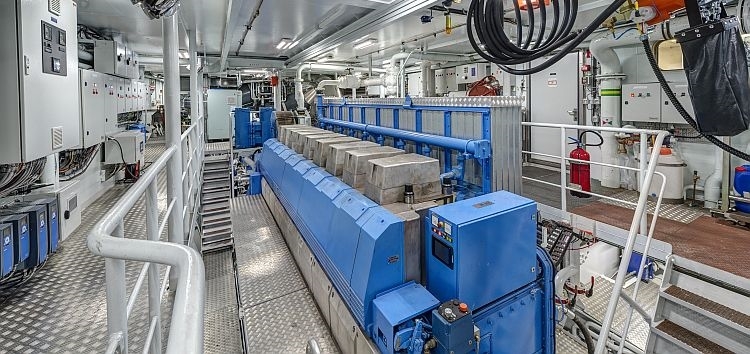
A Spanish-built trawler took the first seagoing installation of Rolls-Royce’s B33:45 diesel engine to sea when it left Freire Shipyard in March, bound for Ålesund in Norway. The vessel, called Holmøy, was built for Norway’s Prestfjord Seafood, part of the Holmøy group, through its fishing vessel operator Holmøy Maritime.
Holmøy is built to Rolls-Royce’s NVC 370 design and its propulsion system includes the company’s Promas propeller/rudder arrangement operating in its InnoDuct nozzle, which is said to increase bollard pull by 4-6 per cent compared with a conventional nozzle and reduce power consumption in transit by 15-20 per cent.
Although the first engine is in service, its development programme continues, said Kjell Harloff, vice president for engines at Rolls-Royce Marine. He was speaking in June in the Norwegian Maritime Competence Centre in Ålesund, which is on the same site as Rolls-Royce Marine. He explained that tests had begun in late 2013 which supported the engine’s launch during the SMM exhibition in September 2014, by when the company was confident of its performance and robustness.
He described the work currently being carried out as “special testing,” telling Norwegian Solutions that it is focusing on stress tests of various parts of the engine when it is running at 100 per cent and 110 per cent load and in what he called ‘ferry cycles’ – in which the engine is subjected to varying low and high loads. In addition, noise and vibration are being monitored and components are being changed to optimise fuel consumption and performance in general, he said.
This work has all been conducted on the inline diesel-fuelled version of the engine and is nearing completion. Tests on the V format design will begin shortly and work on the gas-fuelled variant has recently started. This version could be offered to the market in two to two and a half years, Mr Harloff said, “if we get the projected R&D funding that we need”. This is slightly behind the original schedule, because of delays in the funding process, he explained.
Across the engine range, the different models have much in common. For example, the engine block is the same for diesel and gas versions and cylinder heads are the same for inline and V-versions. This drive for standardisation was one of the initial design concepts that emerged from talks with owners, designers and shipyards, Mr Harloff said.
That work started in 2010 as a plan to replace the Bergen B32:40 engine, which came to market in 1985. Mr Harloff summarised some of the differences between the old engine and its replacement saying that the B33:45 provided 20 per cent more power per cylinder, reducing the number of cylinders needed and thus the engine size and maintenance costs. It is also modular, with production of its ten modules outsourced to countries where costs are lower.
The diesel version complies with IMO Tier II NOx limits and can meet Tier III standards if a selective catalytic reduction unit is added. The gas version will be Tier III compliant. Rolls-Royce does not offer dual-fuel engines. “They are only relevant when there is a perception of a lack of LNG infrastructure,” he said.
Although, at the time of the presentation, only one engine had gone to sea, a further 38 engines for 15 ships – eight of them fishing vessels, had been ordered. Among its other references are a seabed mining vessel for a Singapore operator, two cargo transfer vessels for Norway – lower cost alternatives to shuttle tankers, Mr Harloff explained – two heavy-lift salvage vessels for China and two Polar research vessels for the UK. One of those will be operated by the UK’s Natural Environment Research Council and will be named Sir David Attenborough – a choice of name that emerged from a high-profile public consultation process.
It will be built at the Cammell Laird shipyard in the northwest of England to a Rolls-Royce design and will be fitted with two 9-cylinder and two 6-cylinder B33:45 engines. Other Rolls-Royce equipment on board will include two 4.5m diameter propellers, and automation and control systems.

We use cookies to improve your experience. By continuing to use our site, you accept our Cookies, Privacy Policy,Terms and Conditions. Close X